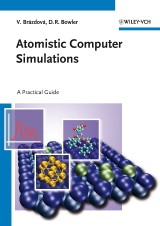Details

Atomistic Computer Simulations
A Practical Guide1. Aufl.
|
106,99 € |
|
| Verlag: | Wiley-VCH |
| Format: | EPUB |
| Veröffentl.: | 16.04.2013 |
| ISBN/EAN: | 9783527671830 |
| Sprache: | englisch |
| Anzahl Seiten: | 361 |
DRM-geschütztes eBook, Sie benötigen z.B. Adobe Digital Editions und eine Adobe ID zum Lesen.
Beschreibungen
<p><b>Many books explain the theory of atomistic computer simulations; this book teaches you how to run them</b></p> <p><br />This introductory "how to" title enables readers to understand, plan, run, and analyze their own independent atomistic simulations, and decide which method to use and which questions to ask in their research project. It is written in a clear and precise language, focusing on a thorough understanding of the concepts behind the equations and how these are used in the simulations. As a result, readers will learn how to design the computational model and which parameters of the simulations are essential, as well as being able to assess whether the results are correct, find and correct errors, and extract the relevant information from the results. Finally, they will know which information needs to be included in their publications.</p> <p>This book includes checklists for planning projects, analyzing output files, and for troubleshooting, as well as pseudo keywords and case studies.</p> <p>The authors provide an accompanying blog for the book with worked examples, and additional material and references: http://www.atomisticsimulations.org/.</p>
Part One: The World at the Atomic Scale<br> 1 Atoms, Molecules and Crystals<br> 2 Bonding<br> 3 Chemical Reactions<br> 4 What Exactly is Calculated?<br> <br> Part Two: Introducing Equations to Describe the System<br> 5 Total Energy Minimization<br> 6 Molecular Dynamics and Monte Carlo<br> <br> Part Three: Describing Interactions Between Atoms<br> 7 Calculating Energies and Forces<br> 8 Electronic Structure Methods<br> 9 Density Functional Theory in Detail<br> <br> Part Four: Setting Up and Running the Calculation<br> 10 Planning a Project<br> 11 Coordinates and Simulation Cells<br> 12 The Nuts and Bolts<br> 13 Tests<br> <br> Part Five: Analyzing Results<br> 14 Looking at Output Files<br> 15 What to do with All the Numbers<br> 16 Visualization<br> 17 Electronic Structure Analysis<br> 18 Comparison to Experiment
<p>“What a gem! This is a truly outstandingly useful book for anyone working in (or supervising students in) projects based around atomistic computer simulations . . . This book is a joy to read and will be of interest to specialists but also to anyone with a general interest in physics and indeed the history of science.” (<i>Contemporary Physics</i>, 11 April 2014)</p>
Dr. Veronika Brazdova obtained her PhD from Humboldt University Berlin in 2005 with Professor J. Sauer. She is currently a Postdoctoral Research Fellow at the London Centre for Nanotechnology, University College London. Her research is focused on computational simulations of solid state surfaces and interfaces, using mainly density functional theory. She has been collaborating closely with experimental groups. She is also an experienced programmer, particularly in Fortran 90 and the Message Passing Interface. She has supervised many undergraduate students taking their first steps in computational physics.<br> <br> Dr. David R. Bowler received his D.Phil. from Oxford University in 1997. He has been a Reader in Physics at UCL since 2005, and held a Royal Society University Research Fellowship from 2002-2010. He is a PI in the London Centre for Nanotechnology and the London-wide Thomas Young Centre. He has driven the development of the massively-parallel linear scaling density functional theory code, Conquest, and collaborates extensively with experimental groups on the growth and properties of nanostructures on semiconductor surfaces.
This title presents an introduction to atomistic simulations, and is ideal for those wanting both to learn how to run atomistic simulations, and to understand the science and approximations underlying these methods. It will enable the reader to understand, plan, run and analyze simulations, as well as to decide which methods are appropriate for a given problem and what questions should be asked in a research project. It is suitable for researchers in physics, chemistry, biology, materials science, earth sciences and other related disciplines. <p>Readers will learn how to design the computational model of a system to be simulated and how to select the correct method for a problem. The text also covers the essential parameters for different simulations, assessing the correctness of results, and finding and correcting errors. The analysis and visualisation of results for publication is covered in detail.</p> <p>This book includes checklists for planning projects, analyzing output fi les, and for troubleshooting, as well as lists of key parameters and case studies.</p>

















